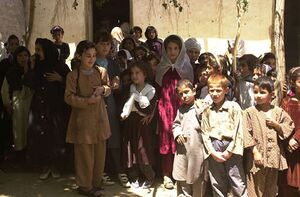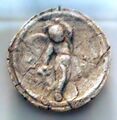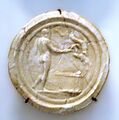بگرام
Bagram
بگرام بګرام | |
|---|---|
Town | |
 Bazaar and part of Bagram (2009) | |
| الإحداثيات: 34°56′25″N 69°15′18″E / 34.9403°N 69.2550°E | |
| Country | |
| Province | Parwan Province |
| District | Bagram District |
| منطقة التوقيت | +04:30 |
بگرام (فارسية: بگرام ؛ Bagram ؛ /bəɡrɑːm/) هي بلدة ومقر مقاطعة بگرام في ولاية پروان في أفغانستان, about 25 kilometers north of the capital Kabul. It is the site of an ancient city located at the junction of the Ghorband and Panjshir Valley, near today's city of Charikar, Afghanistan. The location of this historical town made it a key passage from Ancient India along the Silk Road, leading westwards through the mountains towards Bamiyan, and north over the Kushan Pass to the Baghlan Valley[1] and past the Kushan archeological site at Surkh Kotal, to the commercial centre of Balkh and the rest of northern Afghanistan.
التاريخ
التاريخ القديم
The origin of the name Bagram is not clear, with several theories proposed to describe its origins.[2] Kapisa, an ancient site near the town, is known to be the location of a city once ruled by the Indo-Iranian Kamboja dynasty.

While the Diadochi were warring amongst themselves, the Mauryan Empire was developing in the northern part of the Indian subcontinent. The founder of the empire, Chandragupta Maurya, confronted a Macedonian invasion force led by Seleucus I in 305 BC and following a brief conflict, an agreement was reached as Seleucus ceded Gandhara and Arachosia (centered on ancient Kandahar) and areas south of Bagram (corresponding to the extreme south-east of modern Afghanistan) to the Mauryans. During the 120 years of the Mauryans in southern Afghanistan, Buddhism was introduced and eventually become a major religion alongside Zoroastrianism and local pagan beliefs.
Bagram became the capital of the Kushan Empire in the 1st century; from here they invaded and conquered Peshawar in the south. The "Bagram treasure" as it has been called, is indicative of intense commercial exchanges between all the cultural centers of the classical time, with the Kushan empire at the junction of the land and sea trade between the east and west. However, the works of art found in Bagram, such as the Begram ivories, are either quite purely Hellenistic, Roman, Chinese or Indian, with only little indications of the cultural syncretism found in Greco-Buddhist art.
الفتح الإسلامي
The Islamic conquest of Afghanistan and the adjoining Pashtun region began in 7th century after conquest of Persia. However, the complete Islamization of Afghanistan wasn't achieved until the Ghaznavid rule. The modern-day town is believed to be founded by Babur at the site of the ancient city.[3] In Babur's memoirs, the Baburnama, the emphasis of his visit in 1519 is on the colony of Hindu ascetics at Gurh Kattri (Kur Katri), who fascinated him.[4]
التاريخ الحديث
Bagram hosts the strategic Bagram Airfield, from which most US air activity in Afghanistan took place. The runway was built in 1976, and it was a Soviet air base from 1979 to 1989. There is also a Provincial Reconstruction Team which is led by the US.[5] On 1 July, 2021 US troops departed from the air base, turning the outpost over to the Afghan government after 20 years.
Bagram is also the location of the Parwan Detention Facility; this detention facility was the last prison in Afghanistan under management of the US. It was handed back to the Afghan government on 25 March 2013.[6] The detention centre had earlier come into the attention of the news media as it was claimed that prisoners were tortured (see the article Bagram torture and prisoner abuse). At the time of the hand-over of the facility, human-rights groups like Amnesty International have raised concerns about the treatment of prisoners there.[6]
On December 21, 2015, Bagram was the site of a suicide bombing killing 6 people.[7]
معرض صور
Estàtua d'Harpocrates, Bagram, segle II
Estatueta de Serapis a Bagram.
Motllo de guix mostrant a Cupido.
انظر أيضاً
الهامش
- ^ Cunningham (1871), pp. 16-27
- ^ Afghanistan News (in الإنجليزية). Information Bureau, Royal Afghan Embassy. 1960.
- ^ Bhattacharya, Avijeet (11 October 2017). Journeys on the Silk Road Through Ages. Zorba. p. 192. ISBN 9789386407818. Retrieved 19 January 2018.
- ^ Losty, J. P. Roy, Malini (eds), Mughal India: Art, Culture and Empire, pp. 42-43, 2013, British Library, ISBN 0712358706, 9780712358705
- ^ "Provincial Reconstruction Teams (PRTs)". Institute for the Study of War (in الإنجليزية). Retrieved 2021-07-02.
- ^ أ ب Aljazeera news: US hands over Bagram prison to Afghanistan, 25 March 2013
- ^ Popalzai, Masoud; Starr, Barbara. "6 U.S. troops killed in motorcycle bomb attack in Afghanistan, officials say". CNN. Retrieved 21 December 2015.
الهامش
- The Ancient Geography of India. I. The Buddhist Period, Including the Campaigns of Alexander, and the Travels of Hwen-Thsang. Alexander Cunningham. Trübner and Co., London. Complete and unabridged reprint (2006): Low Price Publications, Delhi.
- Afghanistan: Hidden Treasures from the National Museum, Kabul (2008). Eds., Friedrik Hiebert and Pierre Cambon. National Geographic, Washington, D.C. ISBN 978-1-4262-0374-9.
وصلات خارجية
- Map of Bagram and the surrounding area, Afghanistan Information Management Service (AIMS)
- Human Rights First; Undue Process: An Examination of Detention and Trials of Bagram Detainees in Afghanistan in April 2009 (2009)
- Human Rights First; Arbitrary Justice: Trial of Guantánamo and Bagram Detainees in Afghanistan (2008)














